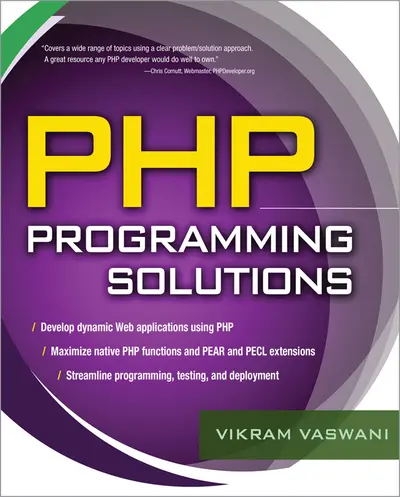My Account Details

ISBN10: 0071596593 | ISBN13: 9780071596596

Step 1 . Download Adobe Digital Editions to your PC or Mac desktop/laptop.
Step 2. Register and authorize your Adobe ID (optional). To access your eBook on multiple devices, first create an Adobe ID at account.adobe.com. Then, open Adobe Digital Editions, go to the Help menu, and select "Authorize Computer" to link your Adobe ID.
Step 3. Open Your eBook. Use Adobe Digital Editions to open the file. If the eBook doesn’t open, contact customer service for assistance.
Find real-world solutions to PHP programming problems
Simplify and shorten the PHP application development cycle using the in-depth information contained in this hands-on guide. PHP Programming Solutions clearly lays out more than 250 programming challenges alongside practical solutions, functioning code, detailed explanations, and usage tips.
Inside, you'll learn to manipulate strings and arrays, work with HTML and Web pages, accept and validate user input, parse XML code, and resolve programming problems using PEAR and PECL widgets and extensions. Plus, you'll get detailed coverage of PHP security issues, SQL database interaction, debugging techniques, and error processing.
- Work with numbers, strings, dates, times, files, and directories
- Build complex data structures using PHP's array manipulation API
- Use functions and classes to build modular, reusable code
- Create, update, and cache HTML documents and Web content
- Obtain and process user input submitted via online forms
- Protect, log, and debug PHP script actions
- Authenticate and track users with sessions and cookies
- Traverse, validate, and transform XML documents
- Store and retrieve data from MySQL, PostgreSQL, and Oracle databases
- Interface with different server types, network protocols, and file formats
- Perform efficient exception handling and error processing
Chapter 1: Working with Strings Chapter 2: Working with Numbers Chapter 3: Working with Dates and Times Chapter 4: Working with Arrays Chapter 5: Working with Functions & Classes Chapter 6: Working with Files and Directories Chapter 7: Working with HTML and Web Pages Chapter 8: Working with Forms, Sessions & Cookies Chapter 9: Working with Databases Chapter 10: Working with XML Chapter 11: Working with Different File Formats and Network Protocols Chapter 12: Working with Exceptions and Other MiscellaneaIndex
Chapter 3: Working with Dates and Times Chapter 4: Working with Arrays Chapter 5: Working with Functions & Classes Chapter 6: Working with Files and Directories Chapter 7: Working with HTML and Web Pages Chapter 8: Working with Forms, Sessions & Cookies Chapter 9: Working with Databases Chapter 10: Working with XML Chapter 11: Working with Different File Formats and Network Protocols Chapter 12: Working with Exceptions and Other MiscellaneaIndex
Chapter 5: Working with Functions & Classes Chapter 6: Working with Files and Directories Chapter 7: Working with HTML and Web Pages Chapter 8: Working with Forms, Sessions & Cookies Chapter 9: Working with Databases Chapter 10: Working with XML Chapter 11: Working with Different File Formats and Network Protocols Chapter 12: Working with Exceptions and Other MiscellaneaIndex
Chapter 7: Working with HTML and Web Pages Chapter 8: Working with Forms, Sessions & Cookies Chapter 9: Working with Databases Chapter 10: Working with XML Chapter 11: Working with Different File Formats and Network Protocols Chapter 12: Working with Exceptions and Other MiscellaneaIndex
Chapter 9: Working with Databases Chapter 10: Working with XML Chapter 11: Working with Different File Formats and Network Protocols Chapter 12: Working with Exceptions and Other MiscellaneaIndex
Chapter 11: Working with Different File Formats and Network Protocols Chapter 12: Working with Exceptions and Other MiscellaneaIndex
Index
Need support? We're here to help - Get real-world support and resources every step of the way.